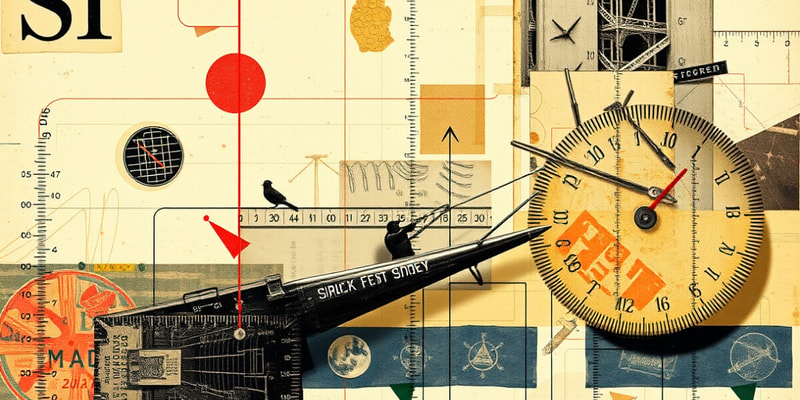Podcast Beta
Questions and Answers
What is the base unit for measuring electric current in the SI system?
Which of the following describes systematic errors?
How would you convert 5 miles into kilometers using the correct conversion factor?
What does dimensional analysis help verify?
Signup and view all the answers
Which derived unit represents pressure in the SI unit system?
Signup and view all the answers
If a measurement shows a consistent deviation from the true value, what type of error is most likely present?
Signup and view all the answers
What is the SI unit for measuring luminous intensity?
Signup and view all the answers
To convert 20 liters to cubic centimeters, which is the appropriate conversion factor?
Signup and view all the answers
What is true regarding derived units?
Signup and view all the answers
What is the purpose of dimensional analysis?
Signup and view all the answers
Which of the following correctly represents the conversion using a conversion factor?
Signup and view all the answers
In converting measurements, what ensures accuracy in the process?
Signup and view all the answers
Which of the following is NOT a base SI unit?
Signup and view all the answers
Study Notes
SI Units
- Definition: The International System of Units (SI) is the standard system of measurement used in science and most of the world.
-
Base Units:
- Length: meter (m)
- Mass: kilogram (kg)
- Time: second (s)
- Electric Current: ampere (A)
- Temperature: kelvin (K)
- Amount of Substance: mole (mol)
- Luminous Intensity: candela (cd)
-
Derived Units:
- Area (m²), Volume (m³), Speed (m/s), Acceleration (m/s²), Force (N), Energy (J), Pressure (Pa).
- Prefix Multipliers: Used to denote powers of ten; e.g., kilo- (10³), centi- (10⁻²), milli- (10⁻³), mega- (10⁶).
Measurement Accuracy
- Definition: Accuracy refers to how close a measured value is to the true value.
-
Types of Errors:
- Systematic Errors: Consistent, reproducible errors due to measurement faults (e.g., miscalibrated instruments).
- Random Errors: Variability in measurements due to unpredictable fluctuations (e.g., environmental factors).
- Precision: Refers to the consistency of repeated measurements.
- Significance: Accurate measurements are crucial for reliable scientific results and data integrity.
Conversions Between Units
- Conversion Factors: Ratios used to convert between different units (e.g., 1 inch = 2.54 cm).
-
Common Conversions:
- Length: 1 inch = 2.54 cm; 1 mile = 1.60934 km.
- Weight: 1 pound = 0.453592 kg; 1 ounce = 28.3495 g.
- Volume: 1 liter = 1,000 cm³; 1 gallon = 3.78541 L.
- Method: Multiply the value in the original unit by the appropriate conversion factor.
Dimensional Analysis
- Definition: A mathematical technique used to convert units or solve problems using the dimensions of the quantities involved.
-
Steps:
- Identify the units of the quantities involved.
- Set up the conversion using conversion factors.
- Cancel out units to achieve desired units.
- Applications: Ensures the consistency and correctness of equations in physics and chemistry, and can verify the dimensions of derived quantities.
- Example: Converting speed from km/h to m/s involves multiplying by (1000 m/1 km) * (1 h/3600 s).
SI Units
- The International System of Units (SI) is the standard system used in science and most of the world.
- There are seven base units in the SI system to measure different physical quantities:
- Length: meter (m)
- Mass: kilogram (kg)
- Time: second (s)
- Electric Current: ampere (A)
- Temperature: kelvin (K)
- Amount of Substance: mole (mol)
- Luminous Intensity: candela (cd)
- Derived units can be formed by combining base units. Examples of derived units include area (m²), volume (m³), speed (m/s), acceleration (m/s²), force (N), energy (J), and pressure (Pa).
- Prefix multipliers are used to denote powers of ten. Examples of prefixes include kilo- (10³), centi- (10⁻²), milli- (10⁻³), and mega- (10⁶).
Measurement Accuracy
- Accuracy refers to how close a measured value is to the true value.
- There exist two main types of errors:
- Systematic errors are consistent and reproducible due to faults in the measurement process, such as miscalibrated instruments.
- Random errors occur due to unpredictable fluctuations in the measurement process arising from environmental factors or random variations.
- Precision refers to the consistency of repeated measurements, or how closely grouped measurements are to each other.
- Accurate measurements are crucial for reliable scientific results and data integrity.
Conversions Between Units
- Conversion factors are ratios used to convert between different units. For example, 1 inch equals 2.54 cm.
- Some common conversions include:
- Length: 1 inch = 2.54 cm; 1 mile = 1.60934 km
- Weight: 1 pound = 0.453592 kg; 1 ounce = 28.3495 g
- Volume: 1 liter = 1,000 cm³; 1 gallon = 3.78541 L
- To convert units, multiply the value in the original unit by the appropriate conversion factor.
Dimensional Analysis
- Dimensional analysis is a technique used to convert units or solve problems involving the dimensions of the quantities involved.
- Key steps for dimensional analysis:
- Identify the units of the quantities involved.
- Set up the conversion using conversion factors.
- Cancel out units to achieve the desired units.
- Dimensional analysis ensures consistency and the correctness of equations in physics and chemistry. This technique can also be used to verify the dimensions of derived quantities.
- For example, converting speed from km/h to m/s involves multiplying by (1000 m/1 km) * (1 h/3600 s).
SI Units
- The International System of Units (SI) provides a standard for measuring physical quantities
- Seven base units form the foundation of the SI: meter (m), kilogram (kg), second (s), ampere (A), kelvin (K), mole (mol), and candela (cd).
- Derived units are formed by combining base units.
- Prefixes like kilo- (10^3) or milli- (10^-3) allow for expressing multiples or fractions of units.
Dimensional Analysis
- Dimensional analysis ensures equations are consistent by comparing dimensions.
- Dimensions represent fundamental quantities using base units: length [L], mass [M], time [T].
- The method involves identifying dimensions in an equation and ensuring both sides have the same dimensions.
- Applications include converting units, deriving equations, and verifying physical laws.
Conversion Factors
- Conversion factors are ratios used to express quantities in different units.
- They are created based on equivalences, like 1 inch = 2.54 cm leading to a conversion factor of 2.54 cm/inch.
- Used to convert units in calculations and ensure consistency in problem-solving.
- Multiplying by the conversion factor facilitates unit conversion by canceling the original unit.
Key Concepts
- SI units provide a unified system for measurement in physics.
- Dimensional analysis is crucial for validating equations and ensuring consistency.
- Conversion factors are practical tools for unit changes without affecting the quantity's value.
Studying That Suits You
Use AI to generate personalized quizzes and flashcards to suit your learning preferences.
Description
Test your knowledge on SI units and the concept of measurement accuracy. This quiz covers base and derived units, prefix multipliers, and various types of measurement errors. Perfect for students in science classes seeking to solidify their understanding.




